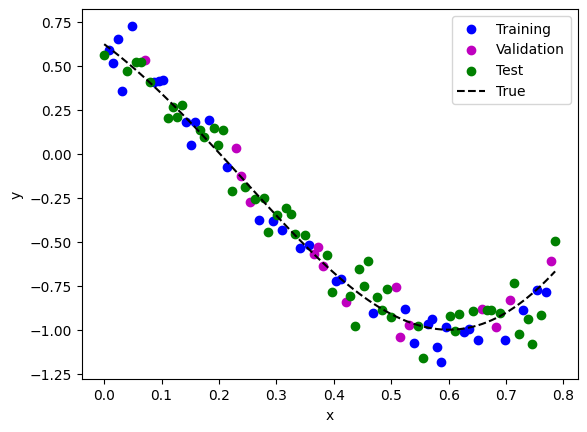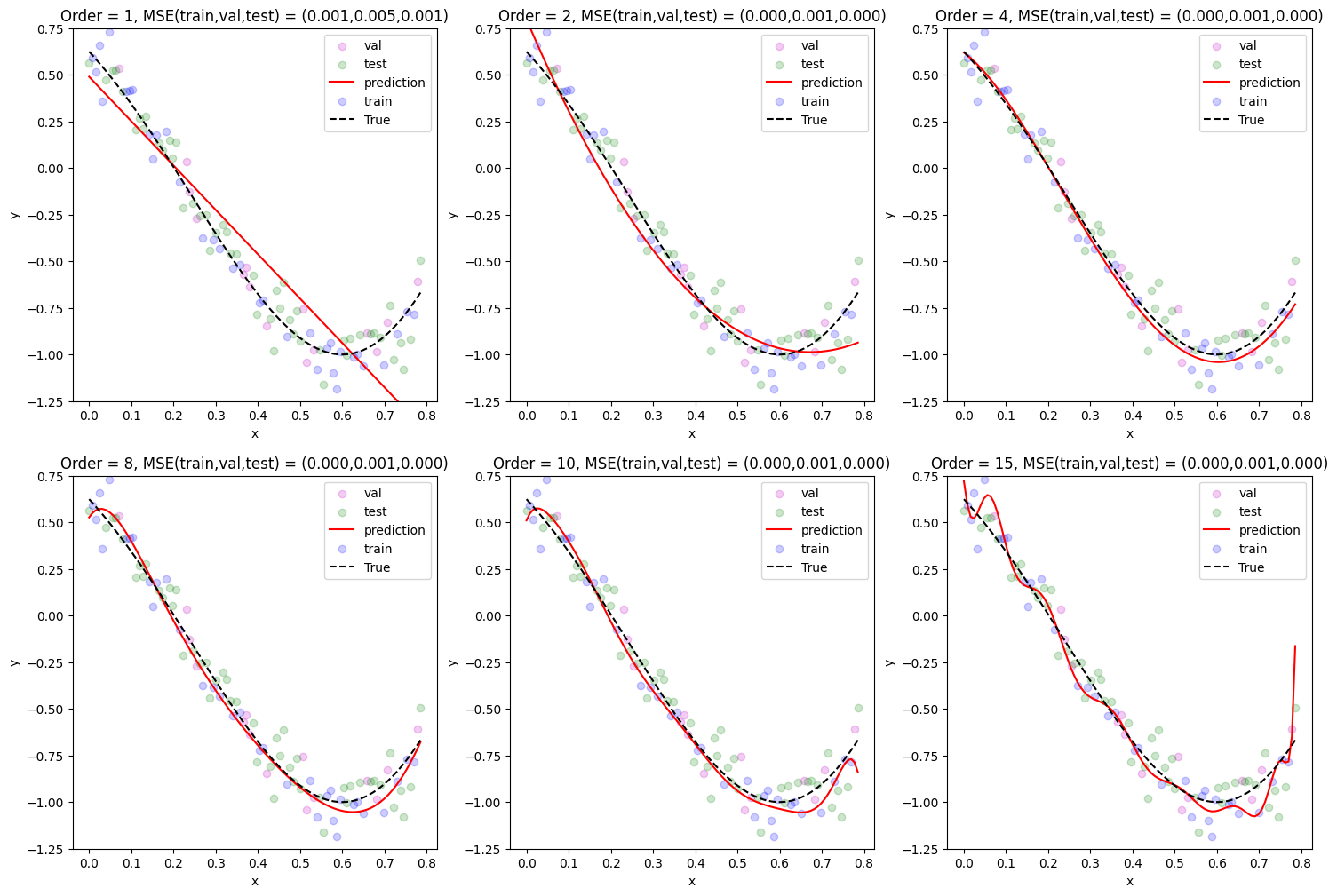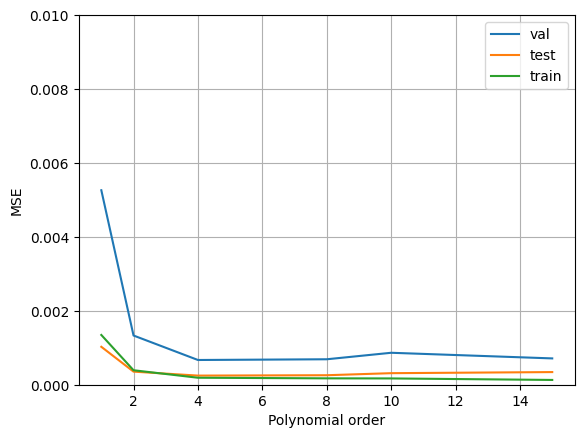Training, Validation and Test Data#
Slides: Training, Validation, and Test Data
ใน part ก่อนหน้า เราได้เห็นตัวอย่างการใช้ polynomial regression มา fit กับข้อมูลที่มีความสัมพันธ์แบบไม่เป็นเชิงเส้น (nonlinear)
ถ้าหากเลือก order ของ polynomial ได้อย่างเหมาะสมก็จะช่วยให้ได้โมเดลที่มีความแม่นยำที่สูง
ถ้าหากเลือก order ที่ต่ำเกินไป จะเกิดปัญหา underfitting
ถ้าหากเลือก order ที่สูงเกินไป ก็จะเกิดปัญหา overfitting
นอกจากนี้ เรายังได้ทดลองใช้เทคนิค regularization มาบรรเทาปัญหา overfitting และได้เห็นถึงความสำคัญในการเลือกค่า \(λ\) ที่เหมาะสม
ใน part นี้ เราจะมาลองเรียนรู้วิธีการเลือก order ของ polynomial โดยการใช้การแบ่งข้อมูลของเราออกเป็น 3 ส่วน ประกอบด้วย
Training data - ข้อมูลสำหรับ fit เพื่อหาค่าตัวแปรของโมเดล เช่น \(\mathbf{\hat{w}}\) ใน linear regression และ polynomial regression
Validation data - ข้อมูลสำหรับเลือก hyper-parameter เช่น order ของ polynomial
Test data - ข้อมูลสำหรับใช้ทดสอบวัดความแม่นยำของโมเดลเท่านั้น กล่าวคือ ข้อมูลชุดนี้จะไม่ถูกนำไป fit เพื่อหาค่าของตัวแปรใดๆ ในโมเดล (เหมือน training data) และข้อมูลนี้ก็ไม่ถูกใช้สำหรับเลือก order ของ polynomial (เหมือน validation data) อีกด้วย
import sys
import numpy as np
import matplotlib.pyplot as plt
from sklearn.linear_model import LinearRegression
from sklearn.preprocessing import PolynomialFeatures
np.random.seed(40) # ตั้งค่า random seed เอาไว้ เพื่อให้การรันโค้ดนี้ได้ผลเหมือนเดิม
ฟังก์ชันจาก part ก่อนหน้า
# ฟังก์ชันสำหรับวัด mean squared error ระหว่างค่าที่ทำนายได้ (y_hat) และค่าผลเฉลย y
def mse(y,y_hat):
return np.mean((y-y_hat)**2)/y.shape[0]
# ฟังก์ชันสำหรับ fit โมเดล polynomial ที่มี order ที่กำหนด และ ทำนายผลของโมเดลหลังจากถูกสอนด้วย training data แล้ว
def fit_and_predict_polynomial(x_train, # ค่า x ที่ใช้เป็น input ของโมเดล (จาก training data)
y_train, # ค่า y ที่ใช้เป็นเฉลยให้โมเดล (จาก training data)
poly_order=4, # ค่า order ของ polynomial ที่เราใช้
x_test_dict=None, # Python dictionary ที่ใช้เก็บชุดข้อมูลที่เราอยากจะนำมาทดสอบ โดยสามารถเลือกชุดข้อมูลผ่าน key ของ dictionary นี้
y_test_dict=None): # Python dictionary ที่ใช้เก็บชุดข้อมูลที่ค่า y ที่เป็นเฉลยของข้อมูลที่นำมาทดสอบ โดยสามารถเลือกชุดข้อมูลผ่าน key ของ dictionary นี้
# สร้างตัวแปรประเภท Python dictionary สำหรับเก็บค่า output ของฟังก์ชันนี้
mse_dict = {} # ค่า mse
out_x = {} # ค่า x ที่ใช้เป็น input ของโมเดล
out_y_hat = {} # ค่า y ที่โมเดลตอบมา
out_y = {} # ค่า y ที่เป็นเฉลย
# สร้างโมเดลสำหรับแปลงจาก x เป็น z
extract_poly_feat = PolynomialFeatures(degree=poly_order, include_bias=True)
# แปลงจากค่า x ให้กลายเป็น z
z_train = extract_poly_feat.fit_transform(x_train)
# สร้างโมเดล y = w_0 + w_1*z + w_2 * z^2 + ...
model_poly = LinearRegression()
# สอนโมเดลจาก training data ที่ input ถูก transfrom จาก x มาเป็น z แล้ว
model_poly.fit(z_train, y_train)
# ทดสอบโมเดลบน training data
y_hat_train = model_poly.predict(z_train)
# ถ้าเกิดว่า user ไม่ได้ให้ test data มา จะใช้ training data เป็น test data
if x_test_dict is None:
x_test_dict = {}
y_test_dict = {}
# เพิ่ม training data เข้าไปใน test_dict เพื่อที่จะใช้เป็นหนึ่งในข้อมูลสำหรับที่จะให้โมเดลลองทำนาย
x_test_dict['train'] = x_train
y_test_dict['train'] = y_train
# ทดสอบโมเดลบนข้อมูลแต่ละชุดข้อมูล (แต่ละชุดข้อมูลถูกเลือกจาก key ของ dictionary)
for curr_mode in x_test_dict.keys():
# แปลงค่า x ให้เป็น z เหมือนขั้นตอนด้านบนที่เรา fit โมเดล
z_test = extract_poly_feat.fit_transform(x_test_dict[curr_mode])
# ทำนายค่า y โดยใช้โมเดล
y_hat_test = model_poly.predict(z_test)
# คำนวณค่า mse บน test data
mse_dict[curr_mode] = mse(y_test_dict[curr_mode], y_hat_test)
# เตรียมข้อมูลเป็น output ของฟังก์ชันนี้ เผื่อเรียกใช้ภายหลัง เช่น การนำเอาข้อมูลไป plot
out_x[curr_mode] = x_test_dict[curr_mode] # เก็บค่า x ที่นำมาทดสอบ
out_y_hat[curr_mode] = y_hat_test # เก็บค่า y ที่โมเดลทำนายออกมา
out_y[curr_mode] = y_test_dict[curr_mode] # เก็บค่า y ที่เป็นผลเฉลย
return out_x, out_y_hat, out_y, mse_dict, model_poly.coef_[0]
กำหนดให้ข้อมูลที่เราเก็บมานั้นเป็นข้อมูลที่มาจากสมการ \(y=sin((x+π/2))^2\) โดยที่ \(0<x< \frac{π}{2}\)
ถ้าหากว่าเราต้องการประมาณค่าฟังก์ชันนี้ด้วย โมเดลที่เราใช้ใน part ที่แล้ว
เราจะมีวิธีการเลือก order \(p\) ของโมเดลนี้อย่างไร
สมมติว่าเรามีโอกาสเก็บข้อมูลมาใช้สำหรับ fit โมเดลเพียงแค่ \(50\) จุด เราสามารถทดลองใช้ขั้นตอนเหล่านี้ในการเลือก order \(p\) ของโมเดล
อาจจะสุ่ม \( 30\% \) ของข้อมูลที่เก็บมา (\(30\%\) ของ \(50\) จุด) มาใช้เป็น validation data \(x_{val}\) และ ใช้ที่เหลือ (\(70\%\) ของ \(50\) จุด) มาใช้เป็น training data \((x_{train}, y_{train})\)
ทดลองสร้าง polynomial ที่มีค่า order \(p\) สักค่าหนึ่งมา และใช้ \(x_{train}\) ในการ fit โมเดล หรือ การหาค่า \(\hat{W}\) นั่นเอง
หลังจากที่ fit โมเดลเรียบร้อยแล้ว เราจะนำเอาโมเดลมาทำนายค่า \(y\) สำหรับทุก ๆ ค่า \(x\) ใน \(x_{val}\) โดยเราจะเรียกค่าที่โมเดลทำนายออกมาว่า \(\hat{y}_{val}\)
ใช้ evaluation metric เช่น \(MSE(y_{val}, \hat{y}_{val})\) มาคำนวณดูความสามารถของโมเดลในการทำนายค่า
ทำซ้ำขั้นตอนที่ 2, 3 และ 4 แต่ใช้ค่า order \(p\) ที่เปลี่ยนไปเรื่อยๆ
ใช้ \(p\) ที่ทำให้โมเดลมีความสามารถในการทำนายค่าบน validation data \((x_{val}, y_{val})\) มากที่สุด เป็นค่า \(p\) ที่จะใช้งานจริง
นำเอาโมเดล polynomial ที่ใช้ค่า order \(p\) จากขั้นตอนที่ 6 มาทดสอบกับ test data
เรามาลองดูข้อมูลชุดนี้กัน
num_points = 100 # จำนวนจุดที่มีทั้งหมด
num_point_observed = 50 # จำนวนจุดที่เราเก็บมาใช้สอนโมเดล (fit โมเดล)
mode2color_dict = {'train':'b', 'val':'m', 'test':'g'} # กำหนดสีสำหรับแต่ละ mode เช่น สีน้ำเงินสำหรับ training data สีเขียวสำหรับ test data
# สร้างข้อมูลที่ไม่มีสัญญาณรบกวนมาแบบละเอียด เพื่อใช้ในการวาดกราฟ (เส้นประสีดำ)
x_whole_line = np.reshape(np.linspace(0, np.pi/4.0, num_points), (-1,1))
y_true_whole_line = np.sin((x_whole_line + np.pi/2)**2)
# เติมสัญญาณรบกวนเข้าไปในค่า y เพื่อจำลองสถานการณ์ที่มีสัญญาณรบกวนเวลาเก็บข้อมูล
y_noisy = y_true_whole_line + 0.1*np.random.randn(*x_whole_line.shape)
# สมมติเราเก็บข้อมูลมาแค่ num_point_observed จุด และเราจะใช้ 30% ของจุดที่เก็บมาเป็น validation data
fraction_val = 0.3
num_val = int(num_point_observed*fraction_val)
num_train = num_point_observed - num_val
## สร้าง training data และ validation data จากข้อมูลที่หยิบมาแบบแรนดอม
shuffle_indices = np.random.permutation(range(num_points))
x_whole_line_shuffle = x_whole_line[shuffle_indices]
y_noisy_shuffle = y_noisy[shuffle_indices]
# Training data
x_train = x_whole_line_shuffle[:num_train]
y_train_noisy = y_noisy_shuffle[:num_train]
# Validation data
x_val = x_whole_line_shuffle[num_train:num_train+num_val]
y_val_noisy = y_noisy_shuffle[num_train:num_train+num_val]
# Test data (จุดที่เราไม่ได้เก็บมา ซึ่งมีจำนวนจุด = num_points - num_points_observed)
x_test = x_whole_line_shuffle[num_train+num_val:]
y_test_noisy = y_noisy_shuffle[num_train+num_val:]
# Plot ข้อมูล x, y ที่มีอยู่
fig, ax = plt.subplots()
ax.scatter(x_train, y_train_noisy, c=mode2color_dict['train'], label='Training')
ax.scatter(x_val, y_val_noisy, c=mode2color_dict['val'], label='Validation')
ax.scatter(x_test, y_test_noisy, c=mode2color_dict['test'], label='Test')
ax.plot(x_whole_line, y_true_whole_line, 'k--', label='True' )
ax.set(xlabel='x', ylabel='y')
ax.legend()
plt.show()

ลองทำตามขั้นตอน 7 ขั้นตอนที่เพิ่งได้อธิบายไป เพื่อเลือก polynomial order ที่เหมาะสม
# สร้าง x_test_dict และ y_test_dict มาเก็บข้อมูลที่เราอยากจะให้โมเดลลองทำนายดู
x_test_dict = {'val': x_val, 'test': x_test, 'all': x_whole_line}
y_test_dict = {'val': y_val_noisy, 'test': y_test_noisy, 'all': y_true_whole_line}
# ลองทดสอบเปลี่ยนค่า polynomial order
poly_order_list = [1, 2, 4, 8, 10, 15]
# สร้างตัวแปรประเภท dictionary สำหรับเก็บค่า mse ของแต่ละชุดข้อมูล (เช่น train, val และ test)
mse_dict = {}
fig, ax = plt.subplots(2, 3, figsize=(18, 12))
fig_row, fig_col = 0, 0
# ใช้ for-loop สำหรับทดลองนำเอา polymonial ที่มีค่า order ต่างๆ มา fit กับข้อมูล
for idx, curr_poly_order in enumerate(poly_order_list):
# fit โมเดล และให้โมเดลทำนายค่า y ออกมา
curr_outputs = fit_and_predict_polynomial(x_train,
y_train_noisy,
poly_order = poly_order_list[idx],
x_test_dict = x_test_dict,
y_test_dict = y_test_dict)
out_x = curr_outputs[0] # ค่า x ที่ถูกใช้ทดสอบโมเดล
out_y_hat = curr_outputs[1] # ค่า y ที่โมเดลทำนายออกมา
out_y = curr_outputs[2] # ค่า y ที่เป็นผลเฉลย
# เก็บค่า mse ของแต่ละชุดข้อมูลที่นำมาทดสอบที่มีค่า order ของ polynomial ที่แตกต่างกัน
for curr_mode in out_x.keys():
if idx == 0:
mse_dict[curr_mode] = [curr_outputs[3][curr_mode]]
else:
mse_dict[curr_mode].append(curr_outputs[3][curr_mode])
# แสดงผล
if idx % 3 == 0 and idx != 0:
fig_col = 0
fig_row += 1
for curr_mode in out_x.keys():
if curr_mode == 'all':
# Plot สิ่งที่โมเดลทำนายมาทุกจุด
ax[fig_row, fig_col].plot(out_x[curr_mode], out_y_hat[curr_mode], 'r', label='prediction')
else:
# Plot ข้อมูล "ผลเฉลย" (ในที่นี้เราใช้ข้อมูลที่มีสัญญาณรบกวนเป็นผลเฉลยสำหรับสอน/วัดผลโมเดล เนื่องจากในสถานการณ์จริง บ่อยครั้ง เราไม่สามารถเข้าถึงข้อมูลที่ไม่มีสัญญาณรบกวนได้)
ax[fig_row, fig_col].scatter(out_x[curr_mode], out_y[curr_mode], c=mode2color_dict[curr_mode], label=curr_mode, alpha=0.2)
# Plot ข้อมูลที่ไม่มี noise สำหรับเป็น reference ไว้ดู
ax[fig_row, fig_col].plot(x_whole_line, y_true_whole_line, 'k--', label='True')
ax[fig_row, fig_col].set(xlabel='x', ylabel='y')
ax[fig_row, fig_col].set_title(f"Order = {curr_poly_order}, MSE(train,val,test) = ({mse_dict['train'][idx]:0.3f},{mse_dict['val'][idx]:0.3f},{mse_dict['test'][idx]:0.3f})")
ax[fig_row, fig_col].set_ylim(-1.25, 0.75)
ax[fig_row, fig_col].legend()
fig_col += 1
# แสดงผล mse ที่มีค่า order ของ polynomial แตกต่างกัน
plt.figure()
for curr_mode in mse_dict.keys():
if curr_mode in ['train','val','test']:
plt.plot(poly_order_list, mse_dict[curr_mode], label=curr_mode)
plt.xlabel('Polynomial order')
plt.ylabel('MSE')
plt.grid()
plt.ylim([0,0.01])
plt.legend()
plt.show()


print(f"The lowest training MSE was achieved with the polynomial of order {poly_order_list[np.argmin(mse_dict['train'])]}")
print(f"The lowest validation MSE was achieved with the polynomial of order {poly_order_list[np.argmin(mse_dict['val'])]}")
print(f"The lowest test MSE was achieved with the polynomial of order {poly_order_list[np.argmin(mse_dict['test'])]}")
The lowest training MSE was achieved with the polynomial of order 15
The lowest validation MSE was achieved with the polynomial of order 4
The lowest test MSE was achieved with the polynomial of order 4
จากตัวอย่างด้านบน เราสังเกตเห็นว่า
order \(p\) ที่ให้ค่า MSE บน validation data ต่ำที่สุด ให้ค่าทำนายบน test data ที่ใกล้เคียงกับค่าที่ถูกต้องมากกว่าค่า \(p\) อื่นๆ ที่เราลองทดสอบทั้งหมด
order \(p\) ที่ต่ำกว่าค่าที่เราเลือกมาก ๆ จะมีปัญหา underfitting อย่างชัดเจน
order \(p\) ที่สูงกว่าค่าที่เราเลือกมาก ๆ จะมีปัญหา overfitting อย่างชัดเจน
นอกจากการแบ่งข้อมูลเป็นส่วน ๆ โดยการเขียนโค้ดเอง เราสามารถแบ่งข้อมูลผ่านการเรียกใช้ train_test_split ของ sklearn.model_selection ได้เช่นกัน ซึ่งสัดส่วนของการแบ่งข้อมูลออกเป็นแต่ละประเภท (training, validation หรือ test) ไม่มีกฎที่ตายตัว ขึ้นอยู่กับสถานการณ์
นอกจากการแบ่งแบบสุ่มที่เราได้ลองใช้ในตัวอย่างด้านบนแล้ว ยังมีอีกหลายวิธี โดยหนึ่งในวิธีที่ได้รับความนิยมมาก คือ การทำ k-fold cross-validation ซึ่งมีขั้นตอนโดยสังเขปดังนี้
แบ่งชุดข้อมูลออกเป็น k ส่วน (เรียกว่า fold)
นำเอา 1 fold มาเป็นตัวสำหรับทดสอบโมเดล และนำเอา fold ที่เหลือ (ซึ่งมีทั้งหมด k-1 folds) มาใช้ fit โมเดล และเก็บค่า evaluation metric ไว้
ทำขั้นตอนที่ 2 ซ้ำ แต่จะเลือก fold ใหม่มาใช้สำหรับทดสอบโมเดล (และจะใช้อีก k-1 folds ที่เหลือสำหรับสอนโมเดล)
ด้วยวิธีนี้ เราจะทำขั้นตอนที่ 2 ทั้งหมด k รอบ (ทุก fold ถูกนำเอามาใช้เป็น fold สำหรับทดสอบ 1 ครั้ง) และเราสามารถนำเอาค่า evaluation metric จากทุก fold มารวมกันเป็นตัวเลขหนึ่งตัว ซึ่งสามารถนำเอาไปใช้ในการเลือก hyperparameter เช่น order ของ polynomial ได้เช่นกัน
ถ้าหากเราเลือก k ที่มีค่าเท่ากับจำนวนจุดข้อมูลที่เรามี เราจะเรียกว่าเราใช้ Leave One Out Cross Validation (LOOCV)
เราสามารถใช้เทคนิค cross validation ผ่านการเรียกใช้ sklearn.model_selection.cross_val_score ได้อย่างง่ายดาย
นอกจาก cross validation แล้ว ยังมีเทคนิคอีกหลายแบบที่ถูกใช้งานอย่างแพร่หลาย เช่น bootstrapping
ผู้จัดเตรียม code ใน tutorial: ดร. อิทธิ ฉัตรนันทเวช

